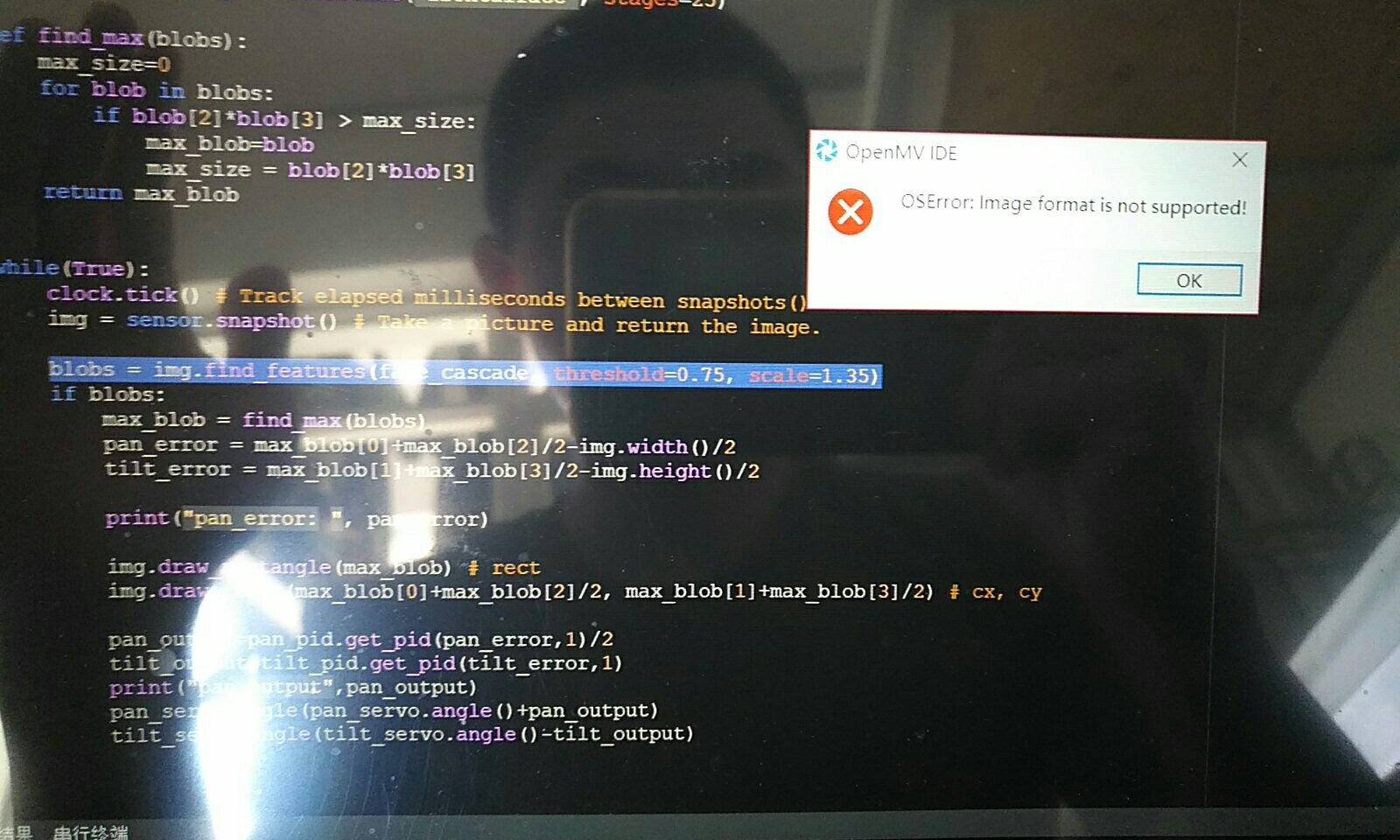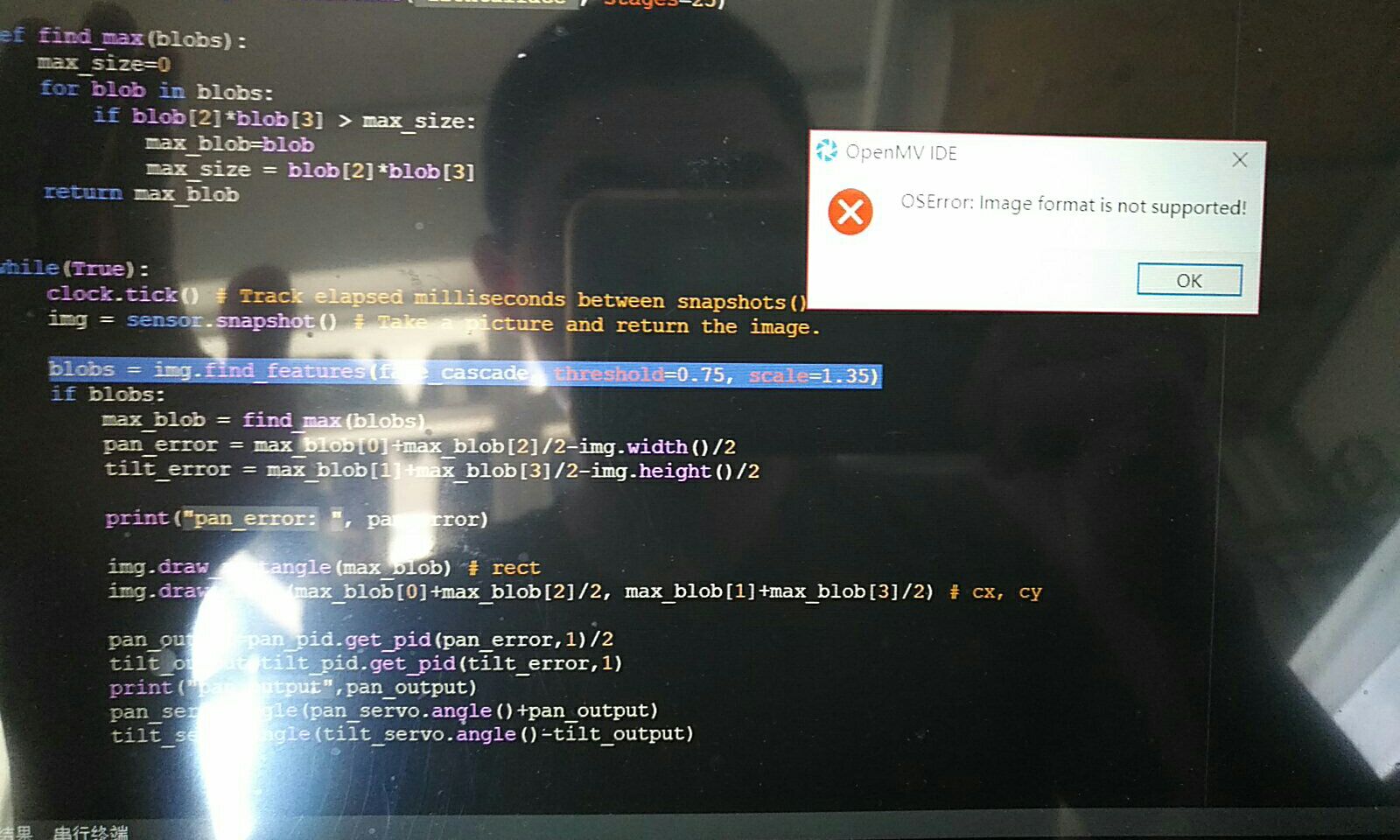@kidswong999
我用的是星瞳星瞳OpenMV3 CamM7
T
txeg
@txeg
0
声望
8
楼层
1825
资料浏览
0
粉丝
2
关注
txeg 发布的帖子
-
RE: 如何修改云台來跟踪數字?发布在 OpenMV Cam
import sensor, image, time from pid import PID from pyb import Servo pan_servo=Servo(1) tilt_servo=Servo(2) red_threshold = (13, 49, 18, 61, 6, 47) pan_pid = PID(p=0.07, i=0, imax=90) #脱机运行或者禁用图像传输,使用这个PID tilt_pid = PID(p=0.05, i=0, imax=90) #脱机运行或者禁用图像传输,使用这个PID #pan_pid = PID(p=0.1, i=0, imax=90)#在线调试使用这个PID #tilt_pid = PID(p=0.1, i=0, imax=90)#在线调试使用这个PID sensor.reset() # Initialize the camera sensor. sensor.set_contrast(1) sensor.set_gainceiling(16) sensor.set_pixformat(sensor.RGB565) # use RGB565. sensor.set_framesize(sensor.QQVGA) # use QQVGA for speed. sensor.skip_frames(10) # Let new settings take affect. sensor.set_auto_whitebal(False) # turn this off. clock = time.clock() # Tracks FPS. face_cascade = image.HaarCascade("frontalface", stages=25) def find_max(blobs): max_size=0 for blob in blobs: if blob[2]*blob[3] > max_size: max_blob=blob max_size = blob[2]*blob[3] return max_blob while(True): clock.tick() # Track elapsed milliseconds between snapshots(). img = sensor.snapshot() # Take a picture and return the image. blobs = img.find_features(face_cascade, threshold=0.75, scale=1.35) if blobs: max_blob = find_max(blobs) pan_error = max_blob[0]+max_blob[2]/2-img.width()/2 tilt_error = max_blob[1]+max_blob[3]/2-img.height()/2 print("pan_error: ", pan_error) img.draw_rectangle(max_blob) # rect img.draw_cross(max_blob[0]+max_blob[2]/2, max_blob[1]+max_blob[3]/2) # cx, cy pan_output=pan_pid.get_pid(pan_error,1)/2 tilt_output=tilt_pid.get_pid(tilt_error,1) print("pan_output",pan_output) pan_servo.angle(pan_servo.angle()+pan_output) tilt_servo.angle(tilt_servo.angle()-tilt_output)
-
RE: 报错 OSError:Image format is not supported!发布在 OpenMV Cam
import sensor, image, time from pid import PID from pyb import Servo pan_servo=Servo(1) tilt_servo=Servo(2) red_threshold = (13, 49, 18, 61, 6, 47) pan_pid = PID(p=0.07, i=0, imax=90) #脱机运行或者禁用图像传输,使用这个PID tilt_pid = PID(p=0.05, i=0, imax=90) #脱机运行或者禁用图像传输,使用这个PID #pan_pid = PID(p=0.1, i=0, imax=90)#在线调试使用这个PID #tilt_pid = PID(p=0.1, i=0, imax=90)#在线调试使用这个PID sensor.reset() # Initialize the camera sensor. sensor.set_contrast(1) sensor.set_gainceiling(16) sensor.set_pixformat(sensor.RGB565) # use RGB565. sensor.set_framesize(sensor.QQVGA) # use QQVGA for speed. sensor.skip_frames(10) # Let new settings take affect. sensor.set_auto_whitebal(False) # turn this off. clock = time.clock() # Tracks FPS. face_cascade = image.HaarCascade("frontalface", stages=25) def find_max(blobs): max_size=0 for blob in blobs: if blob[2]*blob[3] > max_size: max_blob=blob max_size = blob[2]*blob[3] return max_blob while(True): clock.tick() # Track elapsed milliseconds between snapshots(). img = sensor.snapshot() # Take a picture and return the image. blobs = img.find_features(face_cascade, threshold=0.75, scale=1.35) if blobs: max_blob = find_max(blobs) pan_error = max_blob[0]+max_blob[2]/2-img.width()/2 tilt_error = max_blob[1]+max_blob[3]/2-img.height()/2 print("pan_error: ", pan_error) img.draw_rectangle(max_blob) # rect img.draw_cross(max_blob[0]+max_blob[2]/2, max_blob[1]+max_blob[3]/2) # cx, cy pan_output=pan_pid.get_pid(pan_error,1)/2 tilt_output=tilt_pid.get_pid(tilt_error,1) print("pan_output",pan_output) pan_servo.angle(pan_servo.angle()+pan_output) tilt_servo.angle(tilt_servo.angle()-tilt_output)